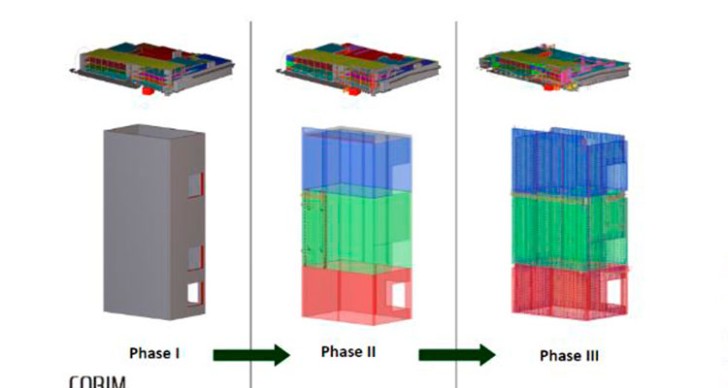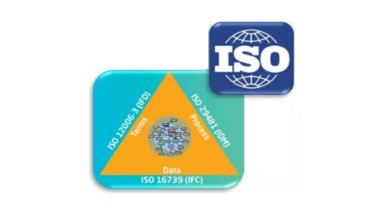
Blog / BIM & Construction Management
Structural BIM: Concepts, Software & Standards
Categories

In today’s post, we go over a masterclass in which BIM engineer José Carlos Lino gave us the fundamentals of structural BIM, the software and some existing standards of when it comes to implementation.
True BIM implementation requires the adoption of the processes, technologies and skills which underpin the approach. No professional in the construction industry can stay competitive without BIM and should, therefore, keep an eye on how BIM is being applied in their market sector. Structural BIM: Concepts José Carlos Lino defines BIM as “a methodology for sharing information and communication between all stakeholders and during all phases of the life cycle of construction that is based on a digital model, accessible by software which allows the virtual manipulation of the same construction."  Since the 1980s, the representation methodologies used in the AEC industry have evolved from manual drawing to CAD 2D and then CAD 3D. In a way, it permitted the professionals to imitate with a cursor what they did with a pencil. However, with BIM, this changes dramatically. “We no longer use geometric entities to communicate, we start to use objects,” Lino summarizes the biggest shift BIM has brought along. With BIM, we passed from an entity-based model to an object-based model. All the fixes are interconnected in a parametric model. So structural engineers have a very good understanding of what an object-based model and a parametric model are.
Since the 1980s, the representation methodologies used in the AEC industry have evolved from manual drawing to CAD 2D and then CAD 3D. In a way, it permitted the professionals to imitate with a cursor what they did with a pencil. However, with BIM, this changes dramatically. “We no longer use geometric entities to communicate, we start to use objects,” Lino summarizes the biggest shift BIM has brought along. With BIM, we passed from an entity-based model to an object-based model. All the fixes are interconnected in a parametric model. So structural engineers have a very good understanding of what an object-based model and a parametric model are.
Structural BIM: Software
There is a variety of software available. The important thing to know here is the difference between a platform and an analysis tool. A platform is a digital environment where you can model the structure and define the geometric and physical model that you intend to analyze. Between the software below, some are some more generic, others more specific.  As for analysis tools, we have: Robot Structural Analysis by Autodesk, SAP 2000; Trical by Arktec, Dlubal Software, Nemeteschek Scia, CypeCAD. These tools are interconnected with the modeling platform where you can define the geometry and interconnected geometry with the other stakeholders, like the architect, the MEP designers, the owner, the contractor, the facility manager.
As for analysis tools, we have: Robot Structural Analysis by Autodesk, SAP 2000; Trical by Arktec, Dlubal Software, Nemeteschek Scia, CypeCAD. These tools are interconnected with the modeling platform where you can define the geometry and interconnected geometry with the other stakeholders, like the architect, the MEP designers, the owner, the contractor, the facility manager.
Structural BIM: Standards
When we speak about structural BIM standards, the most important ones to know are COBIM, Statsbygg BIM Manual, General Services Administration (GSA) BIM Guide and IFC4. In this article, we’re going to go into more detail about COBIM, a standard developed in Finland. Other countries have adopted their work or basing their standard on COBIM.  This standard divides the process into three phases: the program, the tender and the construction. These phases follow each other and each one increases in detail.
This standard divides the process into three phases: the program, the tender and the construction. These phases follow each other and each one increases in detail.
- The program phase offers a general view of the building and we can also observe an elevator box. It’s a general and a raw way of presenting. This phase offers insights into the general design: it has the division between source data from other designers, structural designer’s data model requirements, benefits derived from the model and the printouts that include dimensional drawings of foundation, substructure, each story and elevation drawings
 2. The tender phase is more advanced. As we can observe in the image below, there is a detailed part of the lift walls, one small part of the rebar detailing and some detailings on the general view. In Cobim, the structural design source data includes an IFC model that is in accordance with COBIM Architectural design and MEP design standard, a 2D drawing produced from the model in agreed-upon format and an IFC void reservation model. Some of the structural designer’s data modeling requirements are filling out the model specification, quality assurance, and preparation of the drawings. As for the benefits, we can observe quantity take-off, visualization of design, planning of occupational safety, construction area, construction schedule, etc.
2. The tender phase is more advanced. As we can observe in the image below, there is a detailed part of the lift walls, one small part of the rebar detailing and some detailings on the general view. In Cobim, the structural design source data includes an IFC model that is in accordance with COBIM Architectural design and MEP design standard, a 2D drawing produced from the model in agreed-upon format and an IFC void reservation model. Some of the structural designer’s data modeling requirements are filling out the model specification, quality assurance, and preparation of the drawings. As for the benefits, we can observe quantity take-off, visualization of design, planning of occupational safety, construction area, construction schedule, etc.  3. The construction phase is the most detailed. COBIM understands that the rebar details might be decided depending on the use and what the intentions for the structure model are. One important part of structural BIM is to decide whether you should or not model the rebars.
3. The construction phase is the most detailed. COBIM understands that the rebar details might be decided depending on the use and what the intentions for the structure model are. One important part of structural BIM is to decide whether you should or not model the rebars.  Statsbygg standard or in other words that of Norwegian Directorate of Public Construction and Property and it aims to describe the requirements in respect of Building Information Models (BIM) in the open Industry Foundation Classes (IFC). Both format-generic and discipline-specific requirements stand out for the modeling quality. They recommend the use of Solibri Model Checker. We can find more information on structural engineering modeling under the Domain Specific Requirements. All load-bearing elements such as concrete, wood and steel structures, as well as non-load-bearing concrete structures are covered in this segment. General Services Administration (GSA) BIM Guide is a USA service that deals with thousands of buildings. There’s a special program validation that touches the structural part a lot. IFC or Industry Foundation Classes have had a great development in the structural engineering area and changed a lot the structural model and has helped to understand the part of structural engineering inside of all the domain specifications.
Statsbygg standard or in other words that of Norwegian Directorate of Public Construction and Property and it aims to describe the requirements in respect of Building Information Models (BIM) in the open Industry Foundation Classes (IFC). Both format-generic and discipline-specific requirements stand out for the modeling quality. They recommend the use of Solibri Model Checker. We can find more information on structural engineering modeling under the Domain Specific Requirements. All load-bearing elements such as concrete, wood and steel structures, as well as non-load-bearing concrete structures are covered in this segment. General Services Administration (GSA) BIM Guide is a USA service that deals with thousands of buildings. There’s a special program validation that touches the structural part a lot. IFC or Industry Foundation Classes have had a great development in the structural engineering area and changed a lot the structural model and has helped to understand the part of structural engineering inside of all the domain specifications.


